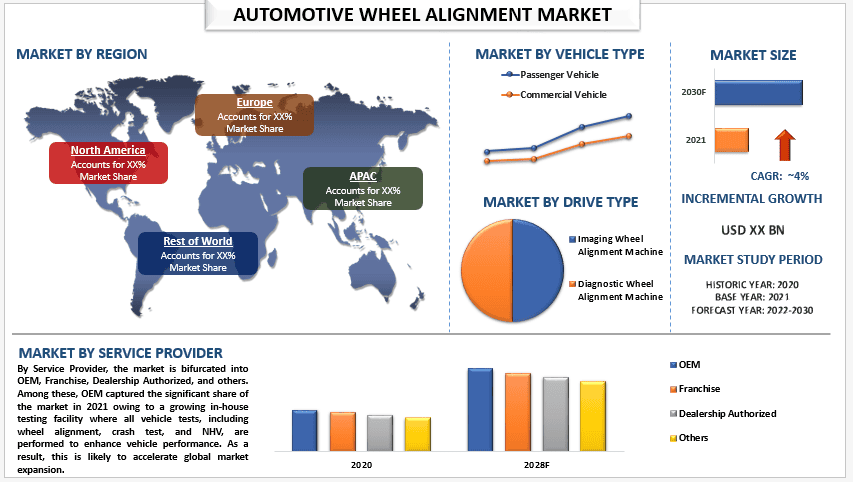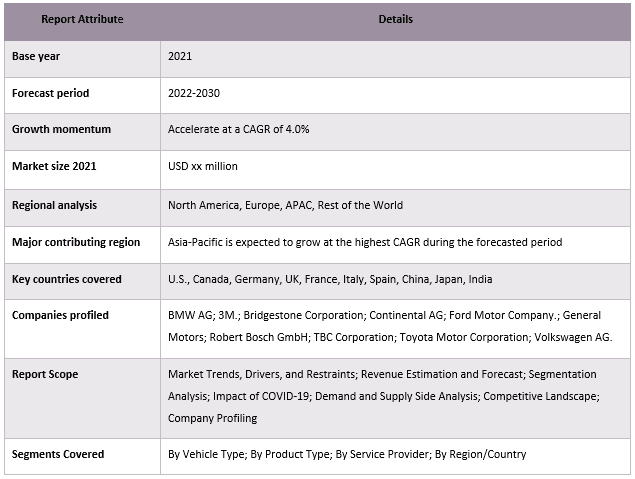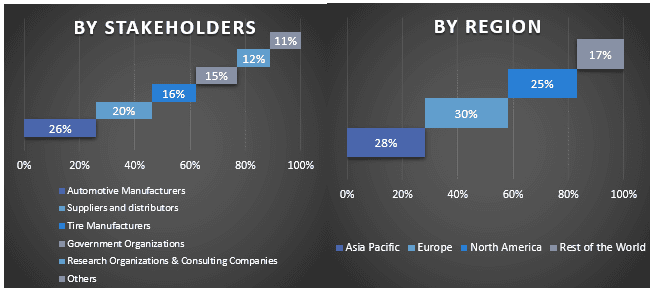Automotive Wheel Alignment Services Market: Current Analysis and Forecast (2022-2030)
Emphasis on Vehicle Type (Passenger Vehicle and Commercial Vehicle); Product Type (Imaging Wheel Alignment Machine and Diagnostic Wheel Alignment Machine]; Service Provider (OEM, Franchise, Dealership Authorized, And Others); and Region/Country

The automotive wheel alignment market is expected to grow at a strong CAGR of around 4% during the forecast period owing to the growing vehicle sales. Automotive wheel alignments are a crucial aspect of vehicle maintenance that involves adjusting the angles of the wheels to ensure they are perpendicular to the ground and parallel to each other. In addition, proper wheel alignment is essential for vehicle safety, tire performance, and fuel efficiency. Moreover, the use of advanced technologies such as 3D imaging and laser-guided wheel alignment system, high demand for used vehicles, and growing awareness of vehicle maintenance are the factors driving the growth of the market.
Some of the major players operating in the market include BMW AG; 3M.; Bridgestone Corporation; Continental AG; Ford Motor Company.; General Motors; Robert Bosch GmbH; TBC Corporation; Toyota Motor Corporation; Volkswagen AG. Several M&As along with partnerships have been undertaken by these players to facilitate customers with hi-tech and innovative products/technologies.
Insights Presented in the Report
“Amongst vehicle type, the Commercial Vehicle will also attain a considerable share of the market during the forecast period.”
Based on vehicle type, the market is segmented into passenger vehicles and commercial vehicles. Amongst these, the commercial vehicle will also attain a considerable share of the market during the forecast period. The factors such as growing e-commerce businesses, construction, and freight transportation which require more adjustments of wheels are anticipated to drive the growth of the segment. For instance, in 2022, Ashok Leyland expects the commercial vehicle industry to grow at a fast pace in the coming quarters, with economic activity gaining momentum and demand picking up across segments.
“Amongst product type, the imaging wheel alignment held a considerable share of the market in 2021.”
By application type, the market is bifurcated into OEM and Aftermarket. Among these, the imaging wheel alignment held a considerable share of the market in 2021. It has more accuracy and allows for precise measurement, improved handling and steering, and imaging wheel alignment is a time-saving process. Hence, these are the factors driving the growth of the segment.
“North America holds the second largest share of the automotive wheel alignment market in 2021.”
The automotive wheel alignment market in North America holds the second largest share globally due to a steady increase in vehicle ownership leading to a greater demand for maintenance and repair services. In addition, the harsh weather conditions in the region can cause significant wear and tear on the vehicle’s wheel and suspension system. Moreover, North America has some of the highest safety standards for vehicles globally, with proper wheel alignment being an essential component of safe driving. The government in North America is also working to standardize safety to reduce the causes of accidents and deaths.
Automotive Wheel Alignment Market Report Coverage

Reasons to buy this report:
- The study includes market sizing and forecasting analysis validated by authenticated key industry experts.
- The report presents a quick review of overall industry performance at one glance.
- The report covers an in-depth analysis of prominent industry peers with a primary focus on key business financials, product portfolios, expansion strategies, and recent developments.
- Detailed examination of drivers, restraints, key trends, and opportunities prevailing in the industry.
- The study comprehensively covers the market across different segments.
- Deep dive regional level analysis of the industry.
Customization Options:
The global automotive wheel alignment market can further be customized as per the requirement or any other market segment. Besides this, UMI understands that you may have your own business needs, hence feel free to contact us to get a report that completely suits your requirements.
Table of Contents
Research Methodology for the Automotive Wheel Alignment Market Analysis (2022-2030)
Analyzing the historical market, estimating the current market, and forecasting the future market of the global automotive wheel alignment market were the three major steps undertaken to create and analyze the adoption of automotive wheel alignment in major regions globally. Exhaustive secondary research was conducted to collect the historical market numbers and estimate the current market size. Secondly, to validate these insights, numerous findings and assumptions were taken into consideration. Moreover, exhaustive primary interviews were also conducted, with industry experts across the value chain of the global automotive wheel alignment market. Post assumption and validation of market numbers through primary interviews, we employed a top-down/bottom-up approach to forecasting the complete market size. Thereafter, market breakdown and data triangulation methods were adopted to estimate and analyze the market size of segments and sub-segments of the industry pertains to. Detailed methodology is explained below:
Analysis of Historical Market Size
Step 1: In-Depth Study of Secondary Sources:
Detail secondary study was conducted to obtain the historical market size of the automotive wheel alignment market through company internal sources such as annual reports & financial statements, performance presentations, press releases, etc., and external sources including journals, news & articles, government publications, competitor publications, sector reports, third-party database, and other credible publications.
Step 2: Market Segmentation:
After obtaining the historical market size of the automotive wheel alignment market, we conducted a detailed secondary analysis to gather historical market insights and share for different segments & sub-segments for major regions. Major segments are included in the report as by vehicle, product type, and service provider. Further country-level analyses were conducted to evaluate the overall adoption of testing models in that region.
Step 3: Factor Analysis:
After acquiring the historical market size of different segments and sub-segments, we conducted a detailed factor analysis to estimate the current market size of the automotive wheel alignment market. Further, we conducted factor analysis using dependent and independent variables such as rail type and application type of the automotive wheel alignment market. A thorough analysis was conducted of demand and supply-side scenarios considering top partnerships, mergers and acquisitions, business expansion, and product launches in the automotive wheel alignment market sector across the globe.
Current Market Size Estimate & Forecast
Current Market Sizing: Based on actionable insights from the above 3 steps, we arrived at the current market size, key players in the global automotive wheel alignment market, and market shares of the segments. All the required percentage shares split, and market breakdowns were determined using the above-mentioned secondary approach and were verified through primary interviews.
Estimation & Forecasting: For market estimation and forecast, weights were assigned to different factors including drivers & trends, restraints, and opportunities available for the stakeholders. After analyzing these factors, relevant forecasting techniques i.e., the top-down/bottom-up approach were applied to arrive at the market forecast for 2028 for different segments and sub-segments across the major markets globally. The research methodology adopted to estimate the market size encompasses:
- The industry’s market size, in terms of revenue (USD) and the adoption rate of the automotive wheel alignment market across the major markets domestically
- All percentage shares, splits, and breakdowns of market segments and sub-segments
- Key players in the global automotive wheel alignment market in terms of products offered. Also, the growth strategies adopted by these players to compete in the fast-growing market
Market Size and Share Validation
Primary Research: In-depth interviews were conducted with the Key Opinion Leaders (KOLs) including Top Level Executives (CXO/VPs, Sales Head, Marketing Head, Operational Head, Regional Head, Country Head, etc.) across major regions. Primary research findings were then summarized, and statistical analysis was performed to prove the stated hypothesis. Inputs from primary research were consolidated with secondary findings, hence turning information into actionable insights.
Split of Primary Participants in Different Regions

Market Engineering
The data triangulation technique was employed to complete the overall market estimation and to arrive at precise statistical numbers for each segment and sub-segment of the global automotive wheel alignment market. data was split into several segments & sub-segments post studying various parameters and trends in the areas of the vehicle type, product type and service providers in the global automotive wheel alignment market.
The main objective of the Global Automotive Wheel Alignment Market Study
The current & future market trends of the global automotive wheel alignment market were pinpointed in the study. Investors can gain strategic insights to base their discretion for investments on the qualitative and quantitative analysis performed in the study. Current and future market trends determined the overall attractiveness of the market at a regional level, providing a platform for the industrial participant to exploit the untapped market to benefit from a first-mover advantage. Other quantitative goals of the studies include:
- Analyze the current and forecast market size of the automotive wheel alignment market in terms of value (USD). Also, analyze the current and forecast market size of different segments and sub-segments.
- Segments in the study include areas of the rail type and application type.
- Define and analysis of the regulatory framework for the automotive wheel alignment
- Analyze the value chain involved with the presence of various intermediaries, along with analyzing customer and competitor behaviors of the industry.
- Analyze the current and forecast market size of the automotive wheel alignment market for the major region.
- Major countries of regions studied in the report include Asia Pacific, Europe, North America, and the Rest of the World
- Company profiles of the automotive wheel alignment market and the growth strategies adopted by the market players to sustain in the fast-growing market.
- Deep dive regional level analysis of the industry
Related Reports
Customers who bought this item also bought










